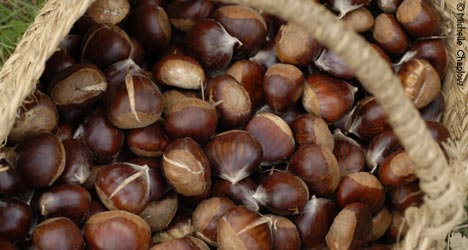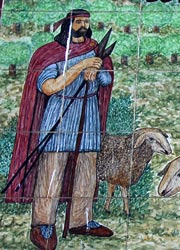
History of Pujerra
Dolmen remains across the Rio Genal valley record Neolithic habitation here. The town hall suggests that Roman and Visigothic remnants were found in the area, although we could not find evidence of this.
A Greek inscription has been found, but this may date from the Byzantine period, which saw a large Christian church built near San Pedro (see the Malaga Sea Board edition). The inscriptions used old Christian symbols, which supports the view that this was later than Greek and almost certainly Byzantine of the 7th century. The mountains yielded ores to Roman miners and it is only logical to suggest that they penetrated the mountains via this pueblo.

King Wanda
It is said that the 7th century Visigothic King Wamba held the lordship of the village of Cenay. He was thought to have been raised in the village, before moving on and being elected king. It may seem odd that such a hidden community would produce such a nobleman, but King Wamba was one of the few kings to have been deposed by a coup and live to tell the tale. He ruled when the Moors made an unsuccessful attempt to invade Spain in 675, and Wamba even called up priests for military service. This did not go down well and so some of his closest religious minders drugged him, shaved his head and dressed him as a monk. The embarrassing ploy worked, and he stepped down from the throne. The Moors had the last laugh when they returned in 711AD.

Visigothic King Wamba
Moors
This harsh environment of the present village site only seems to have been a place of refuge. In the early days after the Moorish invasion, they would have only been interested in exploiting the more accessible and fertile lands, before the arrival of the Berber colonists.
After the Moorish invasion of 711 AD, it is thought that the area was a Visigothic Christian enclave. The Moors tolerated Christian beliefs and having Visgoths in economic fringe lands was a further method of exploiting wealth by taxes not only on Christianity but n uncultivated mountainsides. Evidence of this enclave theory is supported by the birth of the Christian rebel king Ben Hafsun in the nearby village of Parauta in 854 AD. In addition, the use of second century Christian lettering, found on the facades of some of the more recent houses, has been seen as an example of settlement and cultural continuity. However, the street pattern of Pujerra is definitely medieval in origin, suggesting a Moorish foundation. Indeed place name evidence suggests that the name is derived from Buxarra.
The Berber colonists would have been introduced into the area as a control against Christian influence. Other than Pujerra and Cenay, a further Moorish settlement of Benatamin (see Igualeja) existed on the northern edge of the municipal district. The area would have seen an influx of refugees during the 14th century as the Christian conquest advanced from the province of Cadiz. The village would have fallen to the Christians soon after the capture of Ronda in 1485
Christian Reconquest
Pujerra's name suggests that Cenay or Cenajen is a corruption of Sinhaya Tribu. Genay is another name suggested as its origin, based on the name of the Rio Genal. What is known about the community is that when the Christians conquered the area and took a census of the population in 1492, it housed a community of 147. Like many rural villages the census of 1498 showed a drop of 18 but it must have been important enough to be granted the seat of a parish called Santa Marie in 1505. Serving the villages of Igualeja, Benjomin, Parauja, Pujerra and Benahazin, it was endowed with two sacraments and charities. This was one of the largest endowments out of the nine parishes in the Genal and Guadiaro valleys.
The military census of 1492 gives us some interesting statistics into the social geography of this small corner. Cenay was by far the largest settlement, with Pujerra trailing slightly behind with a population of 122. The whole region became part of the Senorio de Ronda in 1496, but by 1501, Pujerra's population had fallen to 55. In 1505 Cenay became the centre of the parish responsible for overseeing the religious needs of five communities.
Like other villages, Pujerra would have suffered Morisco Rebellion uprisings in 1570 and resultant expulsions. A large resettlement plan must have been instigated, for in 1591 40 houses existed in the village. This rose to 1,011 in 1787, as the heavily-worked industrial iron mines became a magnet for incomers. The village must have resisted the French influence in the War of Independence, as in 1814 Fernando VII granted the village a town charter. However, its economic link to the coast was still strong; in 1820, the village was still part of the Judicale district of Estepona . It was only later that the village turned away from the coast and to Ronda for administrative support.
Today the small village has just under 300 inhabitants, with an economy heavily based on the chestnut harvest. The industry is now run by a co-operative, offering its own brand that sells throughout Spain as Christmas approaches.